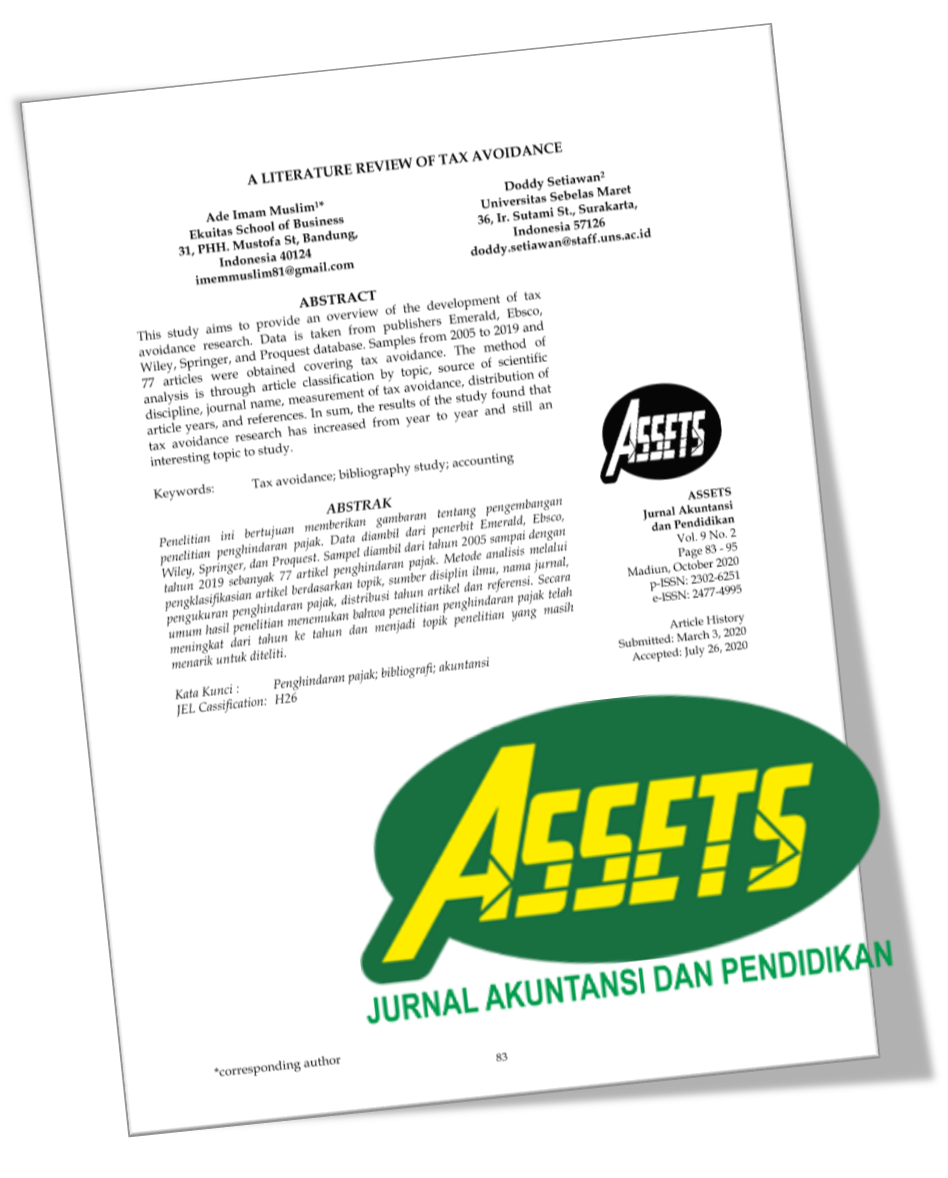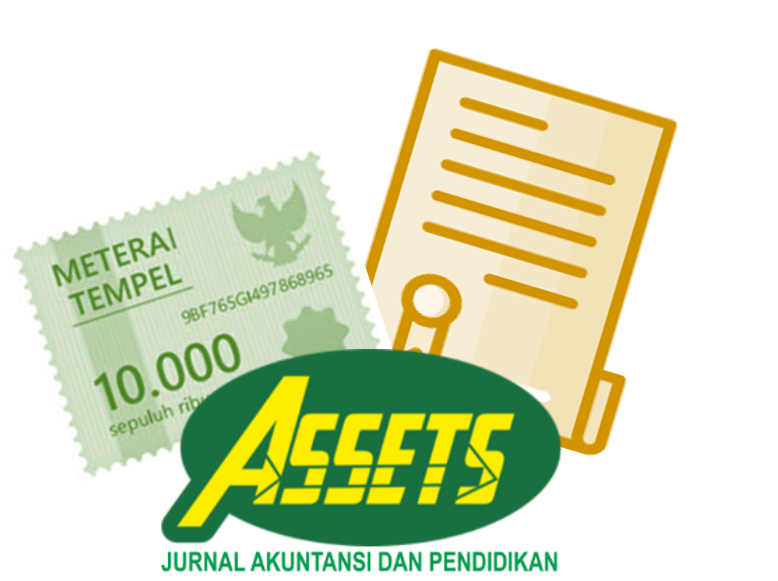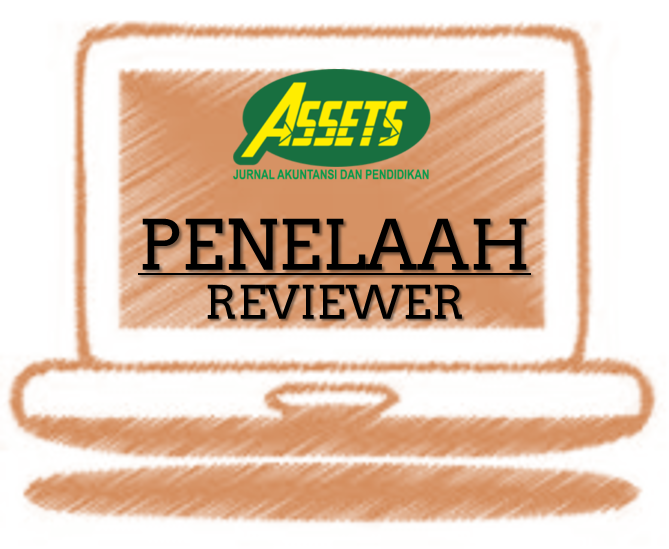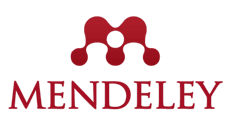DOES ACCOUNTING INFORMATION BECOME PERTINENT TO ASSET REVALUATION DECISION?
DOI:
https://doi.org/10.25273/jap.v11i2.11930Keywords:
Revaluation, Fixed Assets, Logistic Regression, Generalized Estimation Effect, Data Panel, Revaluasi, Aset Tetap, Regresi Logistik, Efek Rerata PopulasiAbstract
ABSTRACT
This research aims to examine whether accounting information proxied by fixed asset intensity, financial leverage, and liquidity affect fixed asset revaluation decisions in the manufacturing sector in Indonesia. The study used the purposive sampling method with 80 firm-year observations derived from 20 chosen companies using logistic regression and generalized effect estimation analysis with panel data. The pooled data found a positive association between fixed asset intensity and fixed asset revaluation, a positive association between financial leverage and fixed asset revaluation, and a negative relationship between liquidity and fixed asset revaluation. This study found that public firms revaluing their fixed asset can provide more relevant accounting information for users of financial statements. The research implies that fixed asset revaluation improves a firm's borrowing capacity and capital structure.
ABSTRAK
Penelitian ini bertujuan untuk menganalisis apakah informasi akuntansi yang diukur melalui intensitas perolehan aset tetap, leverage, dan likuiditas akan mempengaruhi keputusan revaluasi aset tetap pada perusahaan sektor manufaktur di Indonesia. Penelitian ini menggunakan metode purposive sampling untuk mengumpulkan data dari 80 perusahaan-tahun yang dianalisis melalui regresi logistik data panel dan regresi efek rerata populasi. Hasil penelitian ini menunjukkan bahwa intensitas pembelian aset tetap dan financial leverage berpengaruh positif signifikan terhadap keputusan revaluasi aset, sedangkan likuiditas berpengaruh negatif terhadap keputusan revaluasi tersebut. Selain itu, diperoleh kesimpulan bahwa emiten yang merevaluasi aset tetapnya akan meningkatkan kualitas informasi akuntansi yang bermanfaat bagi pengguna laporan keuangan. Implikasi dari penelitian ini adalah perusahaan yang melakukan revaluasi aset tetap akan meningkatkan kapasitas struktur permodalannya.
Downloads
References
Agresti, A. (2002). Categorical Data Analysis. In Wiley Interscience (Second). Wiley. https://doi.org/10.1016/B978-008044910-4.00409-0
Altig, D., Baker, S., Barrero, J. M., Bloom, N., Bunn, P., Chen, S., Davis, S. J., Leather, J., Meyer, B., & Mihaylov, E. (2020). Economic uncertainty before and during the COVID-19 pandemic. Journal of Public Economics, 191, 104274. https://doi.org/10.1016/j.jpubeco.2020.104274
Andison, M. (2015). Fixed Asset Revaluation : Market Reactions. Simposium Nasional Akuntansi, 18(29), 122–135.
Army, J. (2013). Pengaruh Leverage, Likuiditas dan Profitabilitas Terhadap Risiko Sistematis pada Perusahaan Perbankan yang Terdaftar di BEI. Jurnal Akuntansi 1, XVIII, 1–28.
Azouzi, M. A., & Anis, J. (2012). CEO emotional bias and investment decision, Bayesian network method, Management Science Letters, 9(2), 239-256, https://doi.org/10.5267/j.msl.2012.02.012
Barlev, B., Fried, D., Haddad, J. R., & Livnat, J. (2007). Reevaluation of revaluations: A cross-country examination of the motives and effects on future performance. Journal of Business Finance and Accounting, 34(7-8), 1025-1050, https://doi.org/10.1111/j.1468-5957.2007.02019.x
Black, E. L., Sellers, K. F., & Manly, T. S. (1998). Earnings management using asset sales: An international study of countries allowing noncurrent asset revaluation. Journal of Business Finance and Accounting, 25(9-10), 1287-1317, https://doi.org/10.1111/1468-5957.00238
Bloomberg. (2020). Distressed Debt Balloons to Almost $1 Trillion, Nears 2008 Peak - BNN Bloomberg.
Buis, M. L. (2010). Heteroscedasticity in logit / probit model. www.stata.com. https://www.stata.com/statalist/archive/2010-11/msg00996.html
Caers, R., Du Bois, C., Jegers, M., De Gieter, S., Schepers, C., & Pepermans, R. (2006). Principal-agent relationships on the stewardship-agency axis. Journal of Nonprofit Management and Leadership, 17(1), 25-47, https://doi.org/10.1002/nml.129
Davis, J. H., Schoorman, F. D., & Donaldson, L. (1997). Toward a stewardship theory of management. The Academy of Management Review, 22(1), 473–500. http://www.jstor.org/stable/259223
Diantimala, Y., Syahnur, S., & Ridwan, R. (2019). Factors Influencing Asset Revaluation by Indonesian Listed Companies in IFRSs Implementation. 292(Agc), 452–459. https://doi.org/10.2991/agc-18.2019.68
Fahmie, A., & Triandi. (2016). Pengaruh Leverage dan Ukuran Perusahaan Terhadap Keputusan Revaluasi Aset (Studi Empiris pada Perusahaan Manufaktur yang Terdaftar di BEI periode 2012-2016). Jurnal Ilmiah Akuntansi Kesatuan, 6(2), 110-118, https://doi.org/10.37641/jiakes.v6i2.135.
Fathmaningrum, E. S., & Yudhanto, S. K. (2019). Determinants of Fixed Asset Revaluation Decision and Its Impacts on Market Reaction: A Comparative Study in Indonesia and Singapore. Journal of Accounting and Investment, 20(2), 76-98, https://doi.org/10.18196/jai.2002118
Fields, T. D., Lys, T. Z., & Vincent, L. (2001). Empirical research on accounting choice. Journal of Accounting and Economics, 31(1–3), 255–307.
Fioni, D., Rifa, D., Darmayanti, Y., & . (2019). Pengaruh Jaminan Utang, Penurunan Arus Kas dari Aktivitas Operasi dan Fixed Asset Intensity Terhadap Revaluasi Aset Tetap. Reviu Akuntansi dan Bisnis Indonesia, Vol. 3 No.(1), pp:27-37.
Firmansyah, D., Ahmar, N., & Mulyadi, J. (2017). Pengaruh Leverage, Size, Likuiditas, Arus Kas Operasi Terhadap Revaluasi Aset Tetap. Jurnal Ilmiah Manajemen Bisnis, 3(01), 1–18. https://doi.org/http://dx.doi.org/10.22441/jimb.v3i1
Firmansyah, E., & Sherlita, E. (2012). Pengaruh Negosiasi Debt Contracts Dan Political Cost Terhadap Perusahaan Untuk Melakukan Revaluasi Aset Tetap ( Studi Empiris Pada Perusahaan Yang Terdaftar Di Bursa Efek Indonesia Tahun 2010 ). Seminar Nasional Akuntansi dan Bisnis. https://doi.org/2252-3936
Ghozali, D., & Tedjasuksmana, B. (2019). Pengaruh Leverage, Market-to-Book Ratio, Likuiditas, dan Intensitas Aset Tetap Terhadap Keputusan Revaluasi Aset Tetap. Jurnal Akuntansi Kontemporer, 11(2), 74–84. https://doi.org/10.33508/jako.v11i2.2079
Gunawan, F., & Nuswandari, C. (2019). Likuiditas, Leverage, Fixed Asset Intensity, Arus Kas Operasi, dan Ukuran Perusahaan Terhadap Pemilihan Model Revaluasi Aset Tetap (Studi Empiris pada Perusahaan Manufaktur yang Terdaftar di Bursa Efek Indonesia Periode 2013-2017). Dinamika Akuntansi, Keuangan dan Perbankan, 8(1), 1–11. https://doi.org/10.1017/CBO9781107415324.004
Hair, J. F., Black, W. C., Babin, B. J., & Anderson, R. E. (2010). Multivariate Data Analysis. In Vectors. https://doi.org/10.1016/j.ijpharm.2011.02.019
Jaggi, B., & Tsui, J. (2001). Management motivation and market assessment: Revaluations of fixed assets. Journal of International Financial Management and Accounting, 12(2), 160-187. https://doi.org/10.1111/1467-646X.00070
Kasmir. (2011). Analisis Laporan Keuangan. Cetakan ke-11. Depok: Rajawali Pers
Kurniawati, L., & Yushuda, E. B. (2019). Pengaruh Revaluasi Aset Tetap Terhadap Kinerja Perusahaan Pada Masa Mendatang. Jurnal Sumber Artikel Akuntansi Auditing dan Keuangan Vokasi, 3(1), 1-21. https://doi.org/10.1017/CBO9781107415324.004
Latifa, C. A., & Haridhi, M. (2016). Pengaruh Negosiasi Debt Contracts, Political Cost, Fixed Assets Intensity, dan Market-to-Book Value Ratio terhadap Perusahaan Melakukan Revaluasi Aset Tetap (Studi pada Perusahaan Manufaktur yang Terdaftar di Bursa Efek Indonesia Tahun 2010-2014). Jurnal Ilmiah Mahasiswa Ekonomi Akuntansi (JIMEKA), 1(2), 166–176.
Long, J. S., & Mustillo, S. A. (2021). Using Predictions and Marginal Effects to Compare Groups in Regression Models for Binary Outcomes. Sociological Methods & Research, 50(3), 1284–1320. https://doi.org/10.1177/0049124118799374
Manihuruk, T. N. H., & Farahmita, A. (2015). Analisis faktor-faktor yang mempengaruhi pemilihan metode revaluasi aset tetap pada perusahaan yang terdaftar di bursa saham beberapa negara ASEAN. Simposium Nasional Akuntansi 18. https://doi.org/10.3233/978-1-61499-672-9-655
Mood, C. (2010). Logistic Regression: Why We Cannot Do What We Think We Can Do, and What We Can Do About It. European Sociological Review, 26(1), 67–82. https://doi.org/10.1093/esr/jcp006
Musthafa, T. F., Triyuwono, I., & Adib, N. (2020). Application of Asset Revaluation By the Public Assessment Office: a Reflection of Sharia Accounting, Shari’Ah Enterprise Theory. International Journal of Economics, Business and Accounting Research (IJEBAR), 4(03), 16–26. https://doi.org/10.29040/ijebar.v4i03.1281
Nailufaroh, L. (2019). Pengaruh Likuiditas, Fixed Assets Intensity, Market To Book Ratio, Dan Ukuran Perusahaan Terhadap Keputusan Perusahaan Melakukan Revaluasi Aset Tetap. Jurnal Akuntansi : Kajian Ilmiah Akuntansi (JAK), 6(1), 1-19. https://doi.org/10.30656/jak.v6i1.943
OECD. (2020). Corporate sector vulnerabilities during the Covid-19 outbreak: Assessment and policy responses.
Reuters. (2020). Coronavirus bringing record $1 trillion of new global corporate debt in 2020: report | Reuters.
Seng, D., & Su, J. (2010). Managerial Incentives Behind Fixed Asset Revaluations : Evidence from New Zealand Firms. Working Paper Series University of Otago Departement of Accountancy and Business Law, 3(3), 1-33.
Sitepu, H. B., & Silalahi, E. R. . (2019). Pengaruh intensitas aset tetap,leverage,likuiditas,pertumbuhan perusahaan dan ukuran perusahaan terhadap revaluasi aset tetap pada perusahaan manufaktur sektor industri dasar dan kimia yang terdaftar di BEI. Jurnal Reviu Akutansi dan Keuangan, 5(2), 165–190.
Sundaramurthy, C., & Lewis, M. (2003). Control and collaboration: Paradoxes of governance. The Academy of Management Review, 28(3), 397-415. https://doi.org/10.5465/AMR.2003.10196737
Williams, R. (2009). Using Heterogeneous Choice Models to Compare Logit and Probit Coefficients Across Groups. Sociological Methods & Research, 37(4), 531–559. https://doi.org/10.1177/0049124109335735
World Bank. (2020). From Containment to Recovery. East Asia and Pacific Economic Update (October), World Bank, Washinton DC. 10.1596/978-1-4648-1641-3. License: Creative Commons Attribution CC BY 3.0 IGO
Wren-Lewis, S. (2020). The economic effects of a pandemic, retrieved on April 2020 from https://socialeurope.eu/the-economic-effects-of-a-pandemic.
Yulistia M, R., Fauziati, P., Minovia, A. F., & Khairati, A. (2015). Pengaruh Leverage , Arus Kas Operasi , Ukuran Perusahaan dan Fixed Asset Intensity Terhadap Revaluasi Aset Tetap. Simposium Nasional Akuntansi 18. https://doi.org/10.1016/j.jhsa.2014.07.008
Zakaria, A. (2015). An Empirical Analysis of the Motives for and Effects of Fixed Assets Revaluation of Indonesian Publicly Listed Companies. Birmingham City University Press.
Zhang, F., Wei, L., Yang, J., & Zhu, L. (2018). Roles of Relationships Between Large Shareholders and Managers in Radical Innovation: A Stewardship Theory Perspective. Journal of Product Innovation Management, 35(1), 88–105. https://doi.org/10.1111/jpim.12376
Downloads
Additional Files
Published
Issue
Section
License
Perjanjian Lisensi dan Hak Cipta
Saat mengirimkan naskah ke jurnal, penulis menyatakan bahwa:
- Mereka diberi wewenang oleh rekan penulisnya untuk masuk ke dalam perjanjian ini.
- Karya yang dimaksud belum pernah diterbitkan secara resmi sebelumnya, kecuali dalam bentuk abstrak atau sebagai bagian dari kuliah, resensi, tesis, atau overlay jurnal yang diterbitkan.
- Karya yang dimaksud tidak sedang dipertimbangkan untuk diterbitkan di tempat lain,
- Publikasi karya yang dimaksud telah disetujui oleh semua penulis dan oleh otoritas yang bertanggung jawab - secara tahu sama tahu atau eksplisit - dari lembaga tempat pekerjaan itu dilakukan.
- Mereka mengamankan hak untuk mereproduksi materi apa pun yang telah diterbitkan atau dilindungi hak cipta di tempat lain.
- Mereka menyetujui lisensi dan perjanjian hak cipta berikut.
Hak Cipta
Penulis yang menerbitkan dengan ASSETS: Jurnal Akuntansi dan Pendidikan menyetujui persyaratan berikut:
- Penulis mempertahankan hak cipta dan memberikan jurnal hak publikasi pertama dengan karya yang secara bersamaan dilisensikan di bawah Lisensi Atribusi Creative Commons (CC BY-SA 4.0) yang memungkinkan orang lain untuk berbagi karya dengan pengakuan kepenulisan karya dan publikasi awal di jurnal ini.
- Penulis dapat masuk ke dalam pengaturan kontrak tambahan yang terpisah untuk distribusi non-eksklusif dari versi jurnal yang diterbitkan dari karya tersebut (misalnya, mempostingnya ke repositori institusional atau menerbitkannya dalam sebuah buku), dengan pengakuan publikasi awalnya di jurnal ini.
- Penulis diizinkan dan didorong untuk memposting karya mereka secara daring (misalnya di repositori institusional atau di situs web mereka) sebelum dan selama proses pengiriman, karena dapat menghasilkan pertukaran yang produktif, serta kutipan lebih awal dan lebih besar dari karya yang diterbitkan.
License and Copyright Agreement
In submitting the manuscript to the journal, the authors certify that:
- Their co-authors authorize them to enter into these arrangements.
- The work described has not been formally published before, except as an abstract or part of a published lecture, review, thesis, or overlay journal.
- That it is not under consideration for publication elsewhere,
- That its publication has been approved by all the author(s) and by the responsible authorities – tacitly or explicitly – of the institutes where the work has been carried out.
- They secure the right to reproduce any material already published or copyrighted elsewhere.
- They agree to the following license and copyright agreement.
Copyright
Authors who publish with ASSETS: Jurnal Akuntansi dan Pendidikan agree to the following terms:
- Authors retain copyright and grant the journal right of first publication with the work simultaneously licensed under a Creative Commons Attribution License (CC BY-SA 4.0) that allows others to share the work with an acknowledgment of the work's authorship and initial publication in this journal.
- Authors can enter into separate, additional contractual arrangements for the non-exclusive distribution of the journal's published version of the work (e.g., post it to an institutional repository or publish it in a book), with an acknowledgment of its initial publication in this journal.
- Authors are permitted and encouraged to post their work online (e.g., in institutional repositories or on their website) before and during submission, as it can lead to productive exchanges and earlier and more extraordinary citations of published work.

ASSETS: Jurnal Akuntansi dan Pendidikan is licensed under a Creative Commons Attribution-ShareAlike 4.0 International License.










